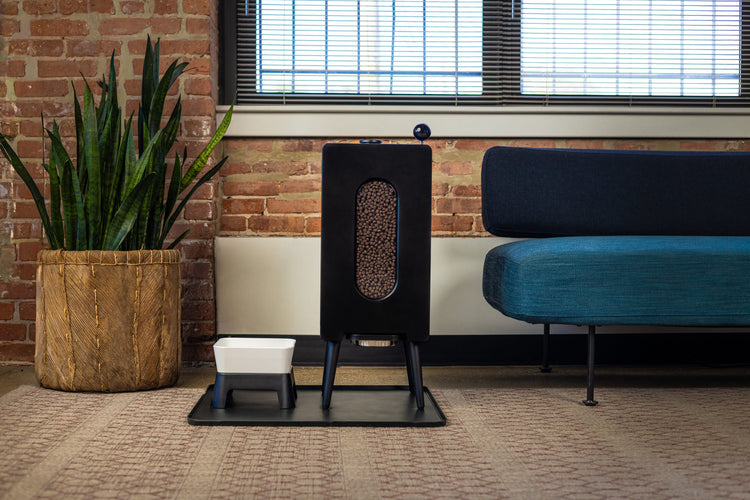How to Store Leftover Canned Dog Food: Practical Tips for Freshness and Convenience
- Houndsy
Table of Contents
- Introduction
- Why Proper Storage of Leftover Canned Dog Food Matters
- Best Practices for Storing Leftover Canned Dog Food
- The Role of Feeding Solutions in Efficient Dog Food Storage
- Common Mistakes and How to Avoid Them
- Practical Tips for Daily Feeding and Food Storage Routines
- Real-Life Scenario: Improving Feeding Habits and Storage
- Bringing It All Together
- FAQs
Introduction
Have you ever opened a can of dog food only to realize your furry friend won’t finish it all in one sitting? Maybe they nibbled a bit, got distracted, or just didn’t feel like finishing their meal that day. Leftover canned dog food is a common scenario in many homes, but how you store it can make a big difference in freshness, safety, and ease of use for the next meal. Did you know that improper storage of wet dog food could lead to spoilage, off-flavors, and even health risks for your beloved companion?
Today, the landscape of dog feeding is evolving with busy pet parents seeking efficient, clean, and consistent solutions. With wet food’s rich nutritional profile, protecting its quality post-opening is vital to preserving its flavor and health benefits. This blog will guide you through everything you need to know how to store leftover canned dog food properly, so your dog enjoys every bite while you enjoy the convenience and peace of mind.
We’ll explore best practices, from airtight containers to refridgeration guidelines, discuss common challenges pet owners face, and highlight smart storage hacks. Throughout, we’ll also connect these insights with how innovative tools like the Houndsy Kibble Dispenser can elevate your feeding routine—making dog care easier, less messy, and more aesthetically pleasing at home.
Are you ready to reconsider your dog’s mealtime storage and transform a simple routine into a streamlined ritual? Let’s dive in.
Why Proper Storage of Leftover Canned Dog Food Matters
The Nutritional and Safety Stakes
Wet dog food packs robust nutrition, often with higher moisture content and natural ingredients that can spoil quickly once exposed to air. Unlike dry kibble, which can last longer if stored correctly, canned dog food becomes vulnerable after opening.
Exposure to air and bacteria causes oxidation and spoilage, which can degrade essential vitamins, cause unpleasant smells, and potentially make your pup sick. A sudden loss of appetite, vomiting, or diarrhea might even indicate your dog ate spoiled food. How often do you inspect leftovers and wonder if they’re still safe?
Avoiding Waste and Saving Money
Leftover canned dog food often goes to waste because owners are unsure how long it remains fresh or hesitate to serve it again after refrigeration. Improper storage also leads to dried-out food and unappealing textures that your dog may refuse.
By mastering how to store leftover canned dog food effectively, you not only protect your pet’s health but reduce waste, save money, and maintain a hassle-free daily feeding routine.
Best Practices for Storing Leftover Canned Dog Food
1. Transfer to an Airtight Container
Once you’ve opened a can of dog food, the best practice is to transfer the leftover portion into a separate airtight container. Why not just keep it in the original can? While cans are excellent sealed packages, once opened, the exposed food can absorb odors, dry out, or oxidize quickly.
Invest in containers that fit the volume of leftover food to minimize excess air, which speeds spoilage. BPA-free plastic containers with secure lids or glass jars with rubber seals are hygienic, easy to clean, and prevent odor transfer in your fridge.
If you’re looking for convenience, silicone lids designed for cans also work well, providing an easy cover solution without extra dishes.
2. Refrigerate Immediately and Maintain Consistent Cold Temperatures
Leftover canned dog food should be refrigerated promptly to slow bacterial growth. The ideal temperature range is between 35°F and 40°F (about 1.6°C to 4.4°C). Avoid storing leftovers in the fridge door or warmer spots, as temperature fluctuations can accelerate spoilage.
Do you keep your dog food in the coldest part of your refrigerator? Consider placing it toward the back, away from door access and temperature swings. This small change can significantly extend freshness.
3. Label Leftovers with Date and Time
It’s easy to lose track of when you opened a can, especially if meal prep gets busy. Clearly labeling your containers with the date and time ensures you know when the food goes bad.
Most experts advise using leftover wet dog food within 3 to 5 days of opening the can. Toss any unused portions after this window to avoid health risks.
4. Avoid Cross-Contamination
When scooping and storing leftover dog food, always use clean utensils and containers to prevent introducing bacteria. Wash hands thoroughly before handling, and don’t leave open canned dog food sitting at room temperature for extended periods.
Do you ever find your fridge smells like wet dog food? Proper sealing and separate storage zones prevent odors from permeating other foods, preserving your entire refrigerator's freshness.
5. Don’t Reheat More Than Once
If you warm up refrigerated canned dog food to room temperature or slightly warm it, avoid reheating or refreezing leftovers. Each heat-cool cycle degrades food quality and can increase bacterial growth risk.
Serve only the portion your dog will eat, and discard any uneaten warmed food. Planning meal sizes upfront can help reduce waste and storage complications.
6. Consider Freezing Small Portions for Longer Storage
If you have large cans or multiple servings leftover, freezing is an option to extend shelf life beyond a few days. Scoop leftover wet food into silicone ice cube trays or small freezer-safe containers. Once frozen solid, transfer to a sealed bag or container.
Thawed portions can be refrigerated for 24 hours before use but should not be refrozen. Note that freezing may slightly alter texture but usually preserves nutritional value well.
The Role of Feeding Solutions in Efficient Dog Food Storage
As pet parents, we understand the challenge of juggling convenience with pet well-being. The daily ritual of feeding is more than a chore—it’s a moment to connect with your dog while ensuring their health.
This is where design-forward tools like the Houndsy Kibble Dispenser step in. While primarily designed for dry food, its thoughtfully crafted features—mid-century modern aesthetics, perfect portion control with a convenient crank, and an easy-to-clean, high-capacity storage—highlight the importance of combining form and function in everyday dog care.
Though canned food needs different storage, the underlying principles of consistency, freshness, and easy access resonate for every feeding practice. Integrating innovative storage and dispensing solutions reduces mess, food waste, and struggle, making feeding less of a battlefield and more a joy.
Common Mistakes and How to Avoid Them
Leaving Leftover Wet Food Out Too Long
Room temperature is a bacteria playground, especially for moist food. Veterinarians agree that wet dog food should not sit out more than 2 hours, or 1 hour if it's hot outside. Leaving food too long invites spoilage and can cause gastrointestinal trouble in your dog.
Using Food Storage Containers That Aren't Airtight or Clean
Some plastic bags or containers may seal poorly or absorb odors, contaminating the food. Make sure to select pet-safe, durable, and airtight options. Avoid reusing food bags from the store; opt for reusable containers designed for pet food instead.
Overfilling Containers
Containers stuffed full with leftover food can trap air pockets, hastening oxidation. Choose containers that closely fit the quantity of leftover food to minimize air exposure.
Trusting Smell Alone to Judge Freshness
Sometimes spoiled food won’t smell obviously sour but can still harbor bacteria. If in doubt about age, texture, or color, discard leftover food to be safe.
Practical Tips for Daily Feeding and Food Storage Routines
-
Pre-Measure Portions: Use a calibrated scoop or the Houndsy Kibble Dispenser for dry food to feed precise amounts, reducing leftover waste.
-
Buy Smaller Cans When Possible: Smaller servings lessen leftover quantities and make storage easier.
-
Use Silicone Can Covers: These are inexpensive and reusable solutions that provide snug fits and keep odors contained in the fridge.
-
Designate a ‘Pet Food Zone’ in the Fridge: Keeps your dog’s food separate to prevent cross-odor and easy access.
-
Frequent Cleaning: Wash containers, lids, and feeding bowls regularly to maintain hygiene and freshness.
-
Freeze Leftovers Smartly: Freeze wet food in manageable portions to give you flexibility, especially if your dog tends to nibble through the day.
Real-Life Scenario: Improving Feeding Habits and Storage
Consider Lisa, a busy dog mom whose 9-month-old pup is transitioning to a new high-quality canned formula. Initially, leftover cans sat open in the fridge, leading to a rancid smell and food getting tossed often. After switching to airtight containers and labeling leftovers, she noticed her pup eagerly licking every bite. Lisa also integrated the Houndsy Kibble Dispenser for kibble portions, streamlining her overall feeding process and reducing clutter. Lisa now feels more confident about maintaining her dog’s nutrition and reducing waste, with the added joy of her stylish dispenser complementing her kitchen.
Bringing It All Together
Understanding how to store leftover canned dog food is crucial to preserving freshness, protecting your dog’s health, and simplifying your feeding routine. Key strategies include transferring leftovers to airtight containers, refrigerating promptly, labeling for use-by timelines, and avoiding reheating leftovers multiple times.
While canned food requires dedicated storage care, complementary tools like the Houndsy Kibble Dispenser embody the spirit of elevating pet care—merging design excellence with convenience and lasting quality.
What’s your current strategy for managing leftover dog food? Could your feeding ritual be smoother, fresher, or just a little more stylish? We invite you to explore how Houndsy can enhance your dog feeding experience while keeping everything simple and beautiful.
FAQs
Q1: How long can leftover canned dog food be kept in the fridge?
Leftover canned dog food should be refrigerated immediately after opening and used within 3 to 5 days. Beyond that, spoilage risk increases, so discard unused portions after this window.
Q2: Can I freeze leftover canned dog food?
Yes, you can freeze leftovers in small portions using ice cube trays or freezer-safe containers to extend shelf life. Thaw in the fridge before use and avoid refreezing thawed food.
Q3: What’s the best container to store leftover canned dog food?
An airtight, BPA-free plastic or glass container with a sealed lid is ideal. Silicone lid caps designed for cans also work well for short-term fridge storage.
Q4: Can I leave opened canned dog food out at room temperature?
No. Opened canned dog food should not sit out longer than 2 hours (or 1 hour in warm environments) to prevent bacterial growth and spoilage.
Q5: How can I avoid the ‘dog food smell’ in my fridge?
Store leftover food in airtight containers, designate a separate fridge spot, and use plastic or silicone covers specifically designed to seal cans and prevent odors from escaping.
Q6: Does reheating wet dog food affect its safety?
Reheating once to room temperature or slightly warm is acceptable, but do not reheat multiple times or refreeze. Serve what you warm up and discard any leftovers to keep your dog safe.
By implementing these expert-backed storage strategies and embracing thoughtful feeding tools like the Houndsy Kibble Dispenser, you can keep your dog’s food fresher longer, protect their well-being, and simplify your daily routine. Ready to elevate your feeding experience? Check out Houndsy’s innovative solutions today!












